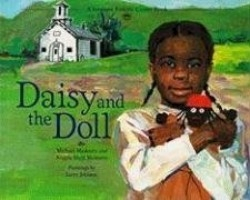Daisy and the Doll
The state of Vermont conjures images of apples, maple sugar candy, individualism. Individualism is expressed in the state’s diverse history and in two new children’s books. The first is about a gutsy small daughter of a former slave and the second, about immigrant brothers who fled oppression and poverty in Prussia. The charm of these handsomely illustrated books from The Vermont Folklife Center is that they are about real Vermonters.
Daisy Turner is an eight-year-old African-American girl living in Grafton, Vermont, in the 1890s. She is aware of her skin color for the first time when her teacher gives each girl a rag doll representing a nationality. During a contest, the girls must read a teacher-prepared speech about the assigned doll. The white girls, who received white dolls, giggle when Daisy is handed a coal black one.
Daisy’s father, trying to boost her morale, tells her she is pretty and encourages her to participate. “You can present your black doll in the program and be just as proud as anyone,” he says. Daisy, however, feels the words of her teacher’s poem “catch in her throat like a bone.” Then she sees her father smile. “I took a deep breath and stood tall, just like the pine trees that surround our house.” Daisy makes up her own poem, confronting the issue of her doll’s color head on. She wins for her “original and honest presentation.”
The tale of two immigrant brothers from Prussia is also true with a surprising twist. Heinrich makes his way to America first, is given a new name by officials and is sent to Vermont to work for a farmer. “As he milked, he would look through the open barn door at the dark green mountains and think, ‘I love it here. I have come to the right place.’” He works hard, learns English and hopes to send for his family. When his brother Friedrich emigrates he does not know his brother’s new name or whereabouts, but is also sent to Vermont. The brothers meet months later when they are asked by their respective employers to mend a fence, unaware that they’ve been living only a mile apart. The folksy yet industrial quality of the illustrations reinforces the labors and struggles of the immigrants in their new land.
The books are as fresh as fall color and as satisfying as cold cider. They each conclude with storytelling or rhyming activities for young readers, and further verification of the authenticity of the story. Heinrich’s grandson, Edward, became Vermont’s Commissioner of Agriculture. Daisy became her family’s historian.
Grants from the Fund for Folk Culture and the Christian A. Johnson Endeavor Foundation supported the books.
Reviewed by
Linda Salisbury
Disclosure: This article is not an endorsement, but a review. The publisher of this book provided free copies of the book to have their book reviewed by a professional reviewer. No fee was paid by the publisher for this review. Foreword Reviews only recommends books that we love. Foreword Magazine, Inc. is disclosing this in accordance with the Federal Trade Commission’s 16 CFR, Part 255.

